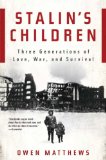Summary | Excerpt | Reading Guide | Reviews | Beyond the Book | Read-Alikes | Genres & Themes | Author Bio

Critics' Opinion:
Readers' Opinion:
First Published:
Sep 2008, 320 pages
Paperback:
Sep 2009, 320 pages
 Book Reviewed by:
Book Reviewed by:
Kim Kovacs
Buy This Book
This article relates to Stalin's Children
The history of Russia and the Soviet Union during the first half of the 20th
century is complex to say the least, characterized by near-constant turmoil. The autocratic
reign of the Tsars came to an end in 1917, sparked by economic hardship
instigated by Russia's involvement in World War I, rapid urban growth, and
the rise of the middle class. Various political parties emerged to vie for
leadership in the ensuing vacuum, with the Bolshevik Party led by Vladimir
Lenin ultimately prevailing. Lenin's death in 1924 led to a power struggle
which left party leadership in the hands of Joseph Stalin.
Stalin's policy of aggressive industrialization led to workers leaving the
farms for employment at the new factories. The result was fewer agricultural
workers producing food, and more industrial workers who needed to be fed. In
addition, the peasants resisted collectivization, destroying assets and
hiding food stores to keep them from being appropriated. Food shortages
resulted. Although scholars attribute the ensuing famine to Stalin's
policies, Stalin blamed the "kulaks" (rich peasant landowners), accusing
them of hoarding grain. He began a campaign of retribution with the goal of
eliminating the kulaks as a class. Anyone accused of being a kulak, kulak
helper or, later, even an ex-kulak, was to be shot, sent to a gulag (labor
camp), or deported to remote and inhospitable parts of the country.
Thousands of deaths were reported, with over a million peasants sentenced to
hard labor at the gulags.
The political situation remained unstable throughout the early 1930s, partly due to the chronic food
shortages. Party loyalties became split between Stalin and Sergei Kirov, a
popular party leader in Leningrad. When Kirov was assassinated in 1934,
Stalin declared the shooting part of a larger conspiracy led by Leon Trotsky
(another rival for power). He instituted a series of purges, beginning with
the arrest and execution of sixteen high-ranking party officials accused of
being conspirators. The purge spread to include anyone who had supported
Trotsky, and then to anyone considered an "enemy of the state." Many
military leaders were convicted of treason. No segment of society was left
untouched.

By late 1938 the purge had achieved its purpose: Stalin's unchallenged rule
of the USSR. 90% of the army's senior leadership had been killed, and 130
members of the 139-member Central Committee had been arrested.
Of the NKVD's 809 high officials - the people responsible for carrying out the purge - only 43 (5%) lived through it, falling victim to an ever increasing paranoia they themselves instigated. The mass arrests
ceased, and Stalin had Yezhov arrested for "overzealousness" in an attempt
to deflect blame from himself. Yezhov was later among the executed.
Filed under Places, Cultures & Identities
![]() This "beyond the book article" relates to Stalin's Children. It originally ran in October 2008 and has been updated for the
September 2009 paperback edition.
Go to magazine.
This "beyond the book article" relates to Stalin's Children. It originally ran in October 2008 and has been updated for the
September 2009 paperback edition.
Go to magazine.





The Funeral Cryer by Wenyan Lu
Debut novelist Wenyan Lu brings us this witty yet profound story about one woman's midlife reawakening in contemporary rural China.
Your guide toexceptional books
BookBrowse seeks out and recommends the best in contemporary fiction and nonfiction—books that not only engage and entertain but also deepen our understanding of ourselves and the world around us.